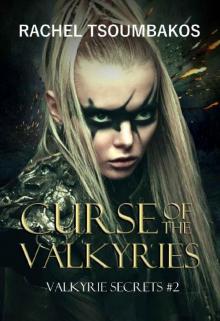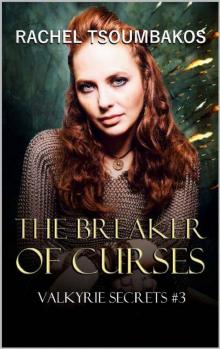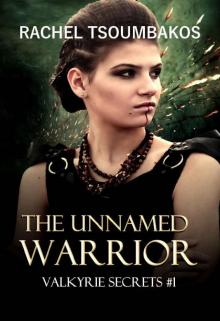- Home
- Rachel Tsoumbakos
The Unnamed Warrior
The Unnamed Warrior Read online
THE UNNAMED WARRIOR
Valkyrie Secrets #1
RACHEL TSOUMBAKOS
VALKYRIE SECRETS: THE UNNAMED WARRIOR
Rachel Tsoumbakos
COPYRIGHT © 2019 by Rachel Tsoumbakos
MYRDDIN PUBLISHING GROUP
ALL RIGHTS RESERVED
All rights reserved. No part of this manuscript may be used or reproduced in any matter whatsoever without written permission, except in the case of brief quotations embodied in critical articles or review. For information contact the author at [email protected]
Cover art credit: © [email protected] and piolka | Depositphotos.com
Cover design: © Rachel Tsoumbakos
Time breaks designed using the Angerthas free font
CONTENTS
Title Page
INTRODUCTION
WHO WERE THE VIKINGS?
WHO ARE THE VALKYRIES?
GLOSSARY
A MAP OF SVAFA’S WORLD
PROLOGUE
Chapter 1: SVAFA
Chapter 2: SVAFA
Chapter 3: SVAFA
Chapter 4: HELGI
Chapter 5: SVAFA
Chapter 6: HELGI
Chapter 7: HELGI
Chapter 8: SVAFA
Chapter 9: HELGI
Chapter 10: HELGI
Chapter 11: HELGI
Chapter 12: HEDINN
Chapter 13: FREYA
Chapter 14: SVAFA
Chapter 15: ALFR
Chapter 16: SVAFA
Chapter 17: HELGI
Chapter 18: SVAFA
Chapter 19: SVAFA
Chapter 20: FREYA
Chapter 21: SVAFA
SNEAK PEEK AT BOOK #2 – Curse of the Valkyries
PROLOGUE
Chapter 1: HELGI
REFERENCES
OTHER BOOKS BY RACHEL TSOUMBAKOS
ABOUT THE AUTHOR
The son of a king | shall be silent and wise,
And bold in battle as well;
Bravely and gladly, | a man shall go,
Till the day of his death shall come.
~ Stanza 15 from the “Havamal” also known as The High One’s Words from the Poetic Edda. Translated by Henry Adams Bellows.
INTRODUCTION
The Vikings and the sagas about them have always been a fascinating subject. They were a vicious breed, fierce, yet steeped in tradition and their own moral code. Along with their raiding ways, instilling fear into all they came across, they had a rich mythology that has come down to us in the present day via a variety of sources. While many of the gods are familiar, the Vikings also had various levels of gods. Among them were the famous Valkyries, a group of women who were supposedly tasked with deciding who lived and died on the battlefield.
Many of the Valkyries’ stories have been lost over time. And, what does remain is fractured, surviving in sections and patchworked together as best as historians of the time could do. However, the fact that so little is known about these women possibly makes them all the more intriguing, which is why this new series has come into existence.
I aim to unravel some of the stories involving the Valkyries, who were supposed to number nine, many of which arrive in the present day with little more than a name. In particular, this trilogy delves into a group of stories that are intertwined by telling the sagas of one Valkyrie who is reborn thrice and the mortal men named Helgi who appear as several reincarnations alongside her.
Many historians have disputed whether or not the Norse believed in reincarnation. However, the fact remains that this trio of stories begins in the Poetic Edda with a story called Helgakvitha Hjorvarthssonar. The first Helgi in this story, the one which is explored in this book, starts his life without a name. It is not until a Valkyrie called Svafa descends from Valhalla that he is named. During the course of their story, they have many adventures. However, both die at the end of the saga with the translation reading that “of Helgi and Svafa it is said that they were born again.”[1] Hence the belief that the other stories in the Poetic Edda containing men called Helgi and two other Valkyries are a continuation of this reincarnation saga.
Historians have argued that the above statement pertaining to the pair being reborn was a result of a translation error. Alternatively, it is suggested that it was used as a way to bridge together many stories that involved men named Helgi.
Regardless, I have chosen to take the words at face value and create a world around these men called Helgi and the women who loved them.
So, settle back and enjoy the ride.
WHO WERE THE VIKINGS?
When one thinks of the Vikings, quite often the first thing they think of is how violent they were. Known as barbarians who raped, pillaged and looted wherever they set foot, popular culture has done little to explore beyond these stereotypes. Considering some of what is known about the Vikings has been written and handed down via Christian sources, it could be possible that the Vikings were merely the brunt of religious propaganda rather than the bloodthirsty descriptive we have come to associate with them.
Also, it is possible the Vikings were a group of people that had very good reasons for doing what they did. Regardless of why the Vikings were so violent, it is known they invaded various parts of Europe before branching out and raiding as far away as the Mediterranean, North Africa, the Middle East, and Central Asia.
The Vikings were not actually a particular race but more a group of people that travelled from Scandinavia. This group was more defined by the fact they were considered foreign to England and the other countries they raided. Another component to grouping these raiders under the umbrella of “Viking” was the fact they weren’t Christian.
The word “Viking,” is generally considered by historians to come from the Scandinavian term “vikingr.” To translate this term into English gives it the meaning of “pirate,” or, alternatively, to mean those who are seafaring, or are a sea warrior, especially considering the word can be broken down further still into the Old Norse, “vik,” meaning bay or creek. Therefore, it is possible this term has been translated in a way that has helped to perpetuate the villainy associated with the Vikings.
The term also represents a small percentage of the Norse population that later came to be known as “Vikings.” For the sake of convenience, I will be referring to the Norse populations of what became to be known in the Viking age as “Vikings.” However, in the following fictional story, I will not be using the term “Viking” or “Vikings,” as this is not how the people of that time referred to themselves. Instead, they will be referred to by their location as an identifier when required.
Originating in the Nordic section of Europe that includes Denmark, Finland, Iceland, Norway and Sweden, the Vikings raided across Europe between the late 8th century through to the late 11th century AD. In fact, the very first recorded Viking raid can be pinpointed to an attack on the abbey at Lindisfarne on 8 June 793. According to historical documents of the time, a scholar working in Frankia wrote a letter describing the attack to the king of Northumbria and the bishop of Lindisfarne.[2]
“Pagans have desecrated God’s sanctuary, shed the blood of saints around the altar, laid waste the house of our hope and trampled the bodies of saints like dung in the streets.”
During the time of the Viking Era, however, Denmark, Finland, Norway, and Sweden were vastly different from the present-day countries we currently know. Not only were some of these countries known by different names, but the boundaries were not set as rigidly as they are today. Being a time when the Christians were converting and there was constant disagreement within the Viking settlements over who ruled what areas, there was a certain fluidity to the borders. Added to this was the fact Vikings were known to
fight among themselves over land parcels and rulership issues.
It is likely the Vikings began raiding for several reasons including the need for richer agricultural resources as well as retaliation against the Christian invasion that was attempting to extinguish their pagan beliefs. The introduction of the Viking age to the rest of Europe occurred during what is known as the Medieval Warm Period. It also coincided with the advent of Charlemagne’s Saxon Wars, an event that saw Christianity enforced throughout Europe. Therefore, the Vikings were, potentially, retaliating against a culture that was foreign to them as the Christians advanced on the pagans during this time.
Regardless of why the Vikings invaded Europe, the fact is they arrived there and managed to integrate into many positions of power. The perfect example of this is Duke Rollo. Rollo was later baptized as Robert and became the first king of Normandy, a region in France. Over time, the Vikings managed to adapt and assimilate themselves into various countries and cultures, disappearing from their initial identity as “sea-faring warriors.” So, while the Viking era may have a fairly set end time, the Vikings were still there, adding their own special flavours to the cultures they had joined.
For the sake of the argument, though, it is considered the Viking age ended in England with the Norman conquest in 1066 at the Battle of Stamford Bridge. In Ireland, the era ended in 1171 with the capture of Dublin by Strongbow. 1263 saw the defeat of King Hakon Hákonarson at the Battle of Largs in Scotland which ended the era of the Vikings there. The Western Isles and the Isle of Man remained under Viking rule until 1266. Finally, Orkney and Shetland finally overthrew the king of Norway around 1469.
WHO ARE THE VALKYRIES?
Traditionally, Valkyries are usually recognised as mythical female creatures that descend on the battlefield and chose the best warriors to return with them to Valhalla. Here they would sup with Odin and spend their time preparing for battle and feasting in the great hall. At the end of time when an event called Ragnarok is meant to occur, these mighty warriors will be summoned in a battle between the gods that will result in the near eradication of life on earth–the gods included.
In this myth, the Valkyries only take the most fearsome and skilled warriors. Therefore, to die in battle was considered a great honour to a Viking as it meant their position in Valhalla and the Ragnarok event was confirmed. Usually, the Valkyries only chose half of the fallen to reside with Odin in Valhalla, the other half went to the goddess Freya. Alternative variants on her name include Freyja and Freja. She also goes by the alternative names: Gefn, Hörn, Mardöll, Sýr, Valfreyja, and Vanadís.
Freya is, essentially, a fertility goddess but she is also considered the ruler of the heavenly afterlife field called Folkvangr. This is where women who were considered to have suffered a noble death go after they die, sent on the behest of the Valkyries.
While we may have heard of the Valkyries, it appears that a great many of the stories and sagas involving them have been lost. Even with the suspected loss of written sources about the Valkyries, there are many mentions of these mythical women throughout the sagas. In addition, there are references to Valkyries or women being cited as such in tales including Grímnismál, Nafnaþulur, Völundarkviða, Völuspá, and Skáldskaparmál, to name just a few. They can also be easily found in the Poetic Edda; the Prose Edda, and Heimskringla.
Along with the Valkyries being associated with Valhalla and the selection of warriors for Ragnarok, there appears to be some overlapping between these mythical women and other supernatural groups in Norse mythology. In particular, there has been some scholarly discussion that associates the Valkyries with the Norns, and the disir.
The Norns are female creatures who are tasked with deciding the destiny of men. The disir are also associated with the fates. This has led to the possible confusion between the Valkyries and these other groups in Norse mythology.
Then, there is also the possibility, as Henry Adams Bellows suggests at points in his translation of the Poetic Edda, that some of these stories associated with the Valkyries might actually just be about ordinary women. Some words within the Poetic Edda have been translated as “Valkyrie.” However, the surrounding words and stanzas do little to suggest that the woman involved is a mythical creature.
While the Valkyries were usually considered creatures above and beyond the realm of humans, there are still stories of them descending for a time to be with the mortal race. This is where a lot of the romantic mythology has captured the imagination of readers. Often, they chose men considered to be great heroes or warriors. In fact, for those who have read the book in my previous series, Vikings: The Truth about Lagertha and Ragnar, you will know that the mighty shieldmaiden Lagertha was suspected to be one of these Valkyries, falling in love with Ragnar and descending for a time to be with him.
So, why don’t you settle back and immerse yourself in some of the stories of the famed Norse Valkyries.
GLOSSARY
When you first start out in Norse mythology and the Viking sagas, there are a few words you may come across that are unclear in definition. Included below are all the terms from this novel that may need an explanation.
Angrboda: (Also, potentially, going by the name of Iárnvidia, which translates to “She of Iron-wood.”) A jotunn that is said to the mother of Fenrir to the god, Loki. She is also the mother of Jörmungandr (the Midgard Serpent) and Hel.
Asgard: This is where the Norse gods dwell. It is divided up into nine worlds. Asgard is said to exist in the sky (although this may be a spiritual reference rather than a literal one) and is joined to earth (or Midgard) by a rainbow bridge called Bitfrost.
Fenrir: (Also known as Fenris-wolf) A giant wolf from Norse mythology. Fenrir is the son of Loki and the giant, Angrboda. It has been foretold he will kill Odin during the events of Ragnarok. In return, he will be killed by Odin’s son Víðarr.
Frey: (Also known as Freyr, or Yngvi-Freyr) Not to be confused with the goddess called Freya, who is his sister, Freyr is said to be the god of sacral kingship, virility and prosperity, and fair weather. He is one of the Vanir, the son of the sea god, Njord. Considered to be an ancestor of one of the Swedish royal houses.
Freya: (Also known as Freyja, Freyia, and Freja) A goddess who is most often associated with love, sex, beauty, fertility, gold, war, and death.
Folkvangr: (Also known as Fólkvangr) A mythical field ruled by Freya. She takes half of those slain in battle here while the other half go to Odin in Valhalla.
Ginungagap: The primordial void that existed before the world was created.
Glasir: A tree with golden red leaves that grows outside the entrance to Valhalla.
Ironwood: A forest said to be located to the east of Midgard that contains jotunn and troll women.
Jarl: An earl.
Jotunheim: (Also known as Jötunheimr or Jǫtunheimr) One of the nine worlds in Norse mythology. It is where the jotunn are said to reside.
Jotunn: (Also known as Jötunn) The jotunn are a mythical creature that resides in Jotunheim. They are often referred to as giants although there is some suggestion that this is not correct and may be a translation error.
Hoenir: the Norse god associated with indecision.
Holmgang: A duel between individuals designed to settle disputes.
Karl: A farmer or craftsperson. The working class of Viking society
Loki: A god known to be a great trickster. He also has the ability to shapeshift.
Mani: The personification of the moon in Norse mythology.
Midgard: The name for the earth, where humans live, as opposed to Asgard, the realm where the gods live.
Muspelheim: One of the Nine Worlds from Norse mythology. It is the homeland of fire and giants.
Niflheim: One of the Nine Worlds from Norse mythology. It is the homeland of primordial darkness, cold, mist, and ice.
Odin: (Also known as the Allfather, Óðinn, Woden) Odin is the head of all the gods in Norse Mythology. He is akin to Zeus from Greek mythology and Jup
iter in Roman mythology as all are considered the top of their pantheons.
Ragnarok: This event is supposed to occur at some time in the future. The gods will be drawn into a massive war using those humans slain on earth and selected to be sent, after death, to Valhalla. Ragnarok will result in the death of most of the Norse gods.
Skald: Someone known to write poetry about heroic deeds and important events. They could be compared to a bard or minstrel as the skald would compose and perform their poetry for entertainment. Although it is unclear whether skalds played musical instruments while performing as a bard did.
Thing: (Also known in various dialects as þing, ding, and ting.) A gathering of the free people of a community that formed a governing assembly. The meeting-place of a thing was referred to as a “thingstead.”
Thingstead: See Thing.
Thralls: Viking slaves. The lowest standing order in Viking culture.
Valhalla: A hall located within Asgard that is said to house all of the warriors who have died during battle or as the result of other heroic deeds.
Valkyries: Mythical women who were sent during battle to select who lived and died. Those chosen by the Valkyries would go to Valhalla or Folkvangr after they died.
Yggdrasil: A tree in Norse mythology that connects the nine worlds.
A MAP OF SVAFA’S WORLD
The world that Svafa lived in can been seen in the map below, using the common names for each area in the Viking Age as well as the places as we now know them. Names in all capital letters, (i.e. SWEDEN) are the current titles. However, during the Viking Age, these areas were less defined or only known by the other name places indicated (i.e. Gotaland).
This map was originally developed from a public domain satellite image that was kindly provided by Koyos.

 Curse of the Valkyries
Curse of the Valkyries The Breaker of Curses (Valkyrie Secrets Book 3)
The Breaker of Curses (Valkyrie Secrets Book 3) The Unnamed Warrior
The Unnamed Warrior Zombie Apocalypse Now!
Zombie Apocalypse Now!